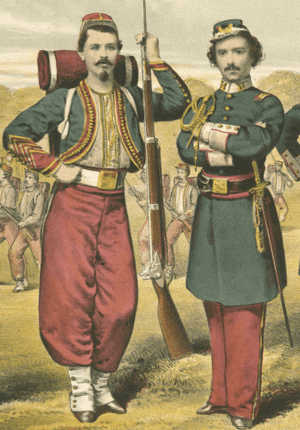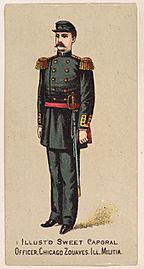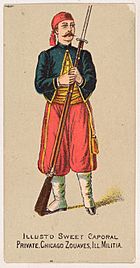United States Zouave Cadets facts for kids
Quick facts for kids United States Zouave Cadets |
|
|---|---|
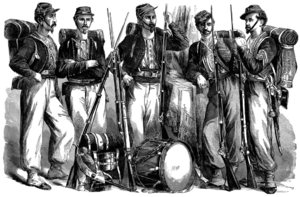 |
|
| Active | 1856–1861 |
| Country | |
| Allegiance | |
| Branch | Militia |
| Type | Zouave infantry |
| Role | Foot guards |
| Size | 61 soldiers, 15 musicians (1860) |
| Armory | Garrett Block (Chicago, Illinois) |
| Nickname(s) | Governor's Guard of Illinois |
| March | "Zouave Cadets Quickstep" (A. J. Vaas) |
| Commanders | |
| Notable commanders |
Elmer Ellsworth |
The United States Zouave Cadets were a special military group from Illinois. They were also known as the Chicago Zouaves. This group became very famous and helped make Zouaves popular across the United States in the mid-1800s.
Elmer Ellsworth formed the United States Zouave Cadets in 1859. He took over an older group called the National Guard Cadets of Chicago. In 1860, the Zouave Cadets went on a tour of the eastern United States. Their unique look and special drills inspired many other similar groups to form right before the American Civil War began.
On January 23, 1860, the Governor of Illinois, William Henry Bissell, gave them the special title of Governor's Guard of Illinois. Their official march music was called "Zouave Cadets Quickstep".
Contents
History of the Zouave Cadets
How the Zouaves Started
After the War of 1812, many northern states stopped funding their local militias. Instead, groups of volunteer soldiers formed. These groups were often made up of people from important families. They chose their own leaders, designed their own uniforms, and paid for most things themselves.
If a volunteer group was well-trained, they could ask their state government for official recognition. If approved, their leaders would get special permission from the Governor. The soldiers could then use the state's armories and weapons. These volunteer groups were more like social clubs than fighting forces. They focused a lot on parades and fancy drills, not so much on battle tactics.
The National Guard Cadets of Chicago started as one of these volunteer groups on March 19, 1856. They were led by Captain Joseph R. Scott. But after three years, they only had 15 members.
Elmer Ellsworth Takes Command
Elmer Ellsworth was a military leader who learned about French Zouaves from his fencing teacher, Charles A. De Villiers. Zouaves were French soldiers known for their special uniforms and fast, fancy drills. Ellsworth started teaching these drills to his own group, the Rockford Greys.
In 1859, members of the National Guard Cadets of Chicago saw the Rockford Greys doing these cool Zouave drills. They were so impressed that they asked Ellsworth to lead their group. Ellsworth agreed, and he changed the National Guard Cadets into the United States Zouave Cadets.
"The members of the corps, with one exception, are all young men of extraordinary muscular power, and there is not one member who is not a gentleman as well as a soldier. The drill is most arduous, but; notwithstanding, every movement, no matter how complex, is executed to perfection."
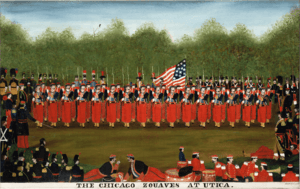
On July 4, 1859, the United States Zouave Cadets showed off their new Zouave uniforms and unique drills for the first time in Chicago. They had 46 members by then. They practiced three evenings a week and became known for their amazing parade ground skills. One person said their drills were "unsurpassed this side of West Point". The next September, about 70,000 people watched them at a big fair in Chicago.
In March 1860, the Governor of Illinois, William Henry Bissell, passed away. The Zouave Cadets were part of his funeral procession. They were given the important job of firing three volleys (shots) during the burial. They had been named the Governor's Guard of Illinois by Governor Bissell earlier that year.
In May, the group performed their exciting drills again. This time, it was for the 1860 Republican National Convention held in Chicago.
The Famous 1860 Tour
In July 1860, the Zouave Cadets went on a tour of the eastern United States. They marched in parades and performed their special drills in many cities. These included Detroit, Michigan, Cleveland, Ohio, Buffalo, New York, New York City, and Boston, Massachusetts. Tens of thousands of people came out to watch them parade through the streets of New York City.
Their tour ended with special performances for important people. They drilled for General Winfield Scott at West Point and for President James Buchanan at the White House. Their last public show was in Pittsburgh, Pennsylvania.
After the Tour and the Civil War
The United States Zouave Cadets mostly stopped existing when the American Civil War began in 1861. Most of their soldiers joined other military groups. In April 1861, after the attack on Fort Sumter, President Abraham Lincoln asked for volunteers. Officers from the Zouave Cadets formed three new Zouave companies. These companies, each with about 80 to 89 men, joined the 19th Illinois Infantry Regiment.
Elmer Ellsworth, who had helped Abraham Lincoln in his 1860 election campaign, became the leader of the 11th New York Infantry. This group was known as "Fire Zouaves". On May 24, 1861, federal forces took over the city of Alexandria, Virginia. Ellsworth was shot and killed by an innkeeper while taking down a Confederate flag. He was the first Union officer to die in the war.
Ellsworth was so famous that his death caused a period of national sadness. Many people felt his death made Northerners even more ready to fight. Ellsworth's body was even placed in the White House for people to see. A newspaper reported that the soldiers in Ellsworth's regiment were so angry they almost burned down the city of Alexandria. Later, a new group of Zouaves, the 44th New York Volunteer Infantry Regiment, was formed in New York to get revenge for his death. They were called "Ellsworth's Avengers". A.J. Vaas, who wrote the Zouave Cadets' march, also wrote a sad song called "Ellsworth Requiem" that year.
Charles A. De Villiers, the French doctor who taught Ellsworth about Zouaves, later became an inspector for a recruiting camp. He was described as a "dapper little gentleman". He was later chosen to lead the 11th Ohio Infantry and became a colonel.
Zouave Uniforms
The Chicago Zouaves wore uniforms that were inspired by French Zouaves. They didn't copy them exactly, but they looked very similar.
The regular soldiers wore red hats called kepis. They had red pants, called chasseur trousers, with white gaiters (covers for the lower leg and shoe). They also wore an open blue shirt with beads and a yellow sash around their waist. Officers wore straight-legged pants and blue shirts with high collars. The loose-fitting chasseur trousers worn by the soldiers allowed them to move easily and perform their special drill movements.
The Unit's March Music
The "Zouave Cadets Quickstep" was a piece of music written by A.J. Vaas. It was officially registered on April 13, 1860. The sheet music for this march became very popular for a short time. By August, a newspaper reported that the publisher was getting "daily orders in the hundreds" for it.
Lasting Impact of the Zouaves
The public shows by the United States Zouave Cadets during their 1860 tour made them very popular. This helped inspire many other Zouave units to form in other states.
A veteran named James Gross, who was part of the Albany Zouave Cadets, remembered seeing the Chicago Zouaves perform in Albany. He said it "aroused such enthusiasm among my young friends and companions that we... decided to form a company to be known as the Albany Zouave Cadets". They wanted to compete with the Chicago Cadets, not knowing that the Civil War was coming soon.
During the American Civil War, there were more than 50 Zouave units in the Union Army alone. The Confederate States also had Zouave forces. However, units inspired by the Chicago Zouaves soon found that the colorful Zouave uniforms were not practical in battle. The bright red pants made them easy targets. During the Civil War, most Zouave units switched to more regular uniforms. But after the war, Zouave-style uniforms slowly reappeared among some militia groups.


